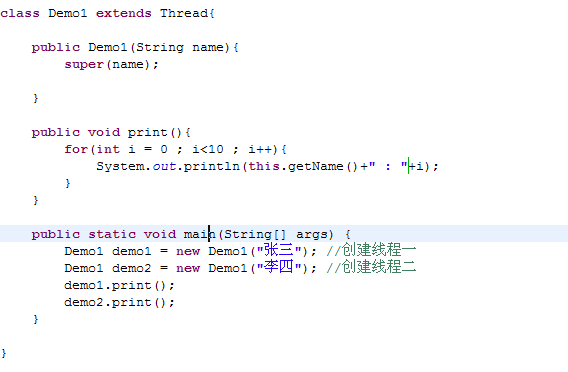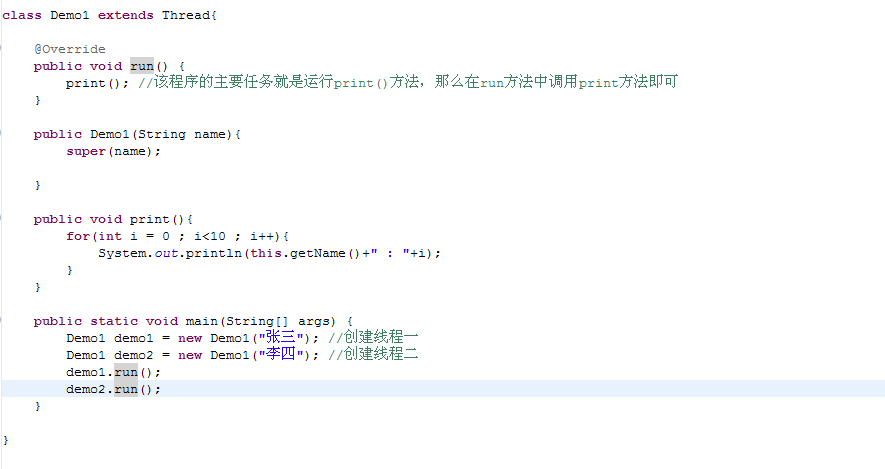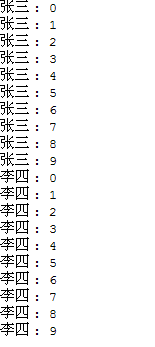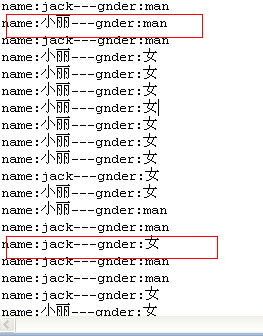1 线程的概述
进程:正在运行的程序,负责了这个程序的内存空间分配,代表了内存中的执行区域。
线程:就是在一个进程中负责一个执行路径。
多线程:就是在一个进程中多个执行路径同时执行。


图上的一键优化与垃圾清除同时在运行,在一个进程中同时在执行了多个任务。
假象:电脑上的程序同时在运行。“多任务”操作系统能同时运行多个进程(程序)——但实际是由于CPU分时机制的作用,使每个进程都能循环获得自己的CPU时间片。但由于轮换速度非常快,使得所有程序好象是在“同时”运行一样。

多线程的好处:
- 解决了一个进程里面可以同时运行多个任务(执行路径)。
- 提供资源的利用率,而不是提供效率。
多线程的弊端:
- 降低了一个进程里面的线程的执行频率。
- 对线程进行管理要求额外的 CPU开销。线程的使用会给系统带来上下文切换的额外负担。
- 公有变量的同时读或写。当多个线程需要对公有变量进行写操作时,后一个线程往往会修改掉前一个线程存放的数据,发生线程安全问题。
- 线程的死锁。即较长时间的等待或资源竞争以及死锁等多线程症状。
- 继承Thread类
2 创建线程的方式
2.1 创建线程的方式一
1、继承Thread类

getName()是获取线程的名字。
执行后的效果:

问题: 先按照顺序运行完了张三,然后接着再按照顺序运行完李四,我们想要的效果是张三和李四做资源的争夺战,也就是先是张三然后李四,没有顺序的执行。这就证明多线程没有起到效果。
- 需要复写run方法,把要执行的任务放在run方法中。

运行效果:
问题: 先按照顺序运行完了张三,然后接着再按照顺序运行完李四,我们想要的效果是张三和李四做资源的争夺战,也就是先是张三然后李四,没有顺序的执行。这就证明多线程没有起到效果。

- 调用start()方法启动线程

效果:

达到了我们预期的效果。
线程的使用细节:
- 线程的启动使用父类的start()方法
- 如果线程对象直接调用run(),那么JVM不会当作线程来运行,会认为是普通的方法调用。
- 线程的启动只能有一次,否则抛出异常
- 可以直接创建Thread类的对象并启动该线程,但是如果没有重写run(),什么也不执行。
- 匿名内部类的线程实现方
2.2 线程的状态

创建:新创建了一个线程对象。
可运行:线程对象创建后,其他线程调用了该对象的start()方法。该状态的线程位于可运行线程池中,变得可运行,等待获取cpu的执行权。
运行:就绪状态的线程获取了CPU执行权,执行程序代码。
阻塞: 阻塞状态是线程因为某种原因放弃CPU使用权,暂时停止运行。直到线程进入就绪状态,才有机会转到运行状态。
死亡:线程执行完它的任务时。
2.3 常见线程的方法
Thread(String name) 初始化线程的名字
getName() 返回线程的名字
setName(String name) 设置线程对象名
getPriority() 返回当前线程对象的优先级 默认线程的优先级是5
setPriority(int newPriority) 设置线程的优先级 虽然设置了线程的优先级,但是具体的实现取决于底层的操作系统的实现(最大的优先级是10 ,最小的1 , 默认是5)。
currentThread() 返回CPU正在执行的线程的对象
1 class ThreadDemo1 extends Thread{ 2 public ThreadDemo1(){} 3 public ThreadDemo1( String name ){ 4 super( name ); 5 } 6 7 public void run(){ 8 int i = 0; 9 while(i < 30){ 10 i++; 11 System.out.println( this.getName() + " "+ " : i = " + i); 12 System.out.println( Thread.currentThread().getName() + " "+ " : i = " + i); 13 System.out.println( Thread.currentThread() == this ); 14 System.out.println( "getId()" + " "+ " : id = " + super.getId() ); 15 System.out.println( "getPriority()" + " "+ " : Priority = " + super.getPriority() ); 16 } 17 } 18 } 19 20 class Demo3 { 21 public static void main(String[] args) { 22 ThreadDemo1 th1 = new ThreadDemo1("线程1"); 23 ThreadDemo1 th2 = new ThreadDemo1("线程2");
24 // 设置线程名 25 th1.setName( "th1" ); 26 th2.setName( "th2" );
27 // 设置线程优先级 1 ~ 10 28 th1.setPriority( 10 ); 29 th2.setPriority( 7 );
30 // 查看SUN定义的线程优先级范围 31 System.out.println("max : " + Thread.MAX_PRIORITY ); 32 System.out.println("min : " + Thread.MIN_PRIORITY ); 33 System.out.println("nor : " + Thread.NORM_PRIORITY );
34 th1.start(); 35 th2.start(); 36 System.out.println("Hello World!"); 37 } 38 } 39
练习:模拟卖票
1 package com.hjh.day20190124; 2 3 public class ThreadTest2 extends Thread { 4 5 static int num = 10; 6 7 public ThreadTest2() {} 8 public ThreadTest2(String name) { 9 super(name); 10 } 11 12 @Override 13 public void run() { 14 15 try { 16 for(num=10;num>0;num--) { 17 synchronized(this.getClass()){ 18 Thread.sleep(1000); 19 if(num>1) { 20 System.out.println(this.getName()+":卖了编号为"+num+"的票"); 21 }else if(num==1) { 22 System.out.println(this.getName()+":卖了编号为"+num+"的票,票卖完了,耶耶耶耶耶"); 23 }if(num==0) { 24 return; 25 } 26 27 } 28 } 29 } catch (InterruptedException e) { 30 e.printStackTrace(); 31 } 32 } 33 34 35 public static void main(String[] args) { 36 ThreadTest2 th1 = new ThreadTest2("h"); 37 ThreadTest2 th2 = new ThreadTest2("s"); 38 th1.start(); 39 th2.start(); 40 41 } 42 43 }
运行结果:
h:卖了编号为10的票
s:卖了编号为9的票
h:卖了编号为8的票
s:卖了编号为7的票
s:卖了编号为6的票
s:卖了编号为5的票
h:卖了编号为4的票
s:卖了编号为3的票
s:卖了编号为2的票
s:卖了编号为1的票,票卖完了,耶耶耶耶耶
2.4 创建线程的方式二
创建线程的第二种方式.实现Runnable接口.
该类中的代码就是对线程要执行的任务的定义.
1:定义了实现Runnable接口
2:重写Runnable接口中的run方法,就是将线程运行的代码放入在run方法中
3:通过Thread类建立线程对象
4:将Runnable接口的子类对象作为实际参数,传递给Thread类构造方法
5:调用Thread类的start方法开启线程,并调用Runable接口实现类的run方法
为什么要将Runnable接口的子类对象传递给Thread的构造函数,因为自定义的run方法所属对象是Runnable接口的子类对象,所以要让线程去执行指定对象的run方法
1 package cn.itcast.gz.runnable; 2 3 public class Demo1 { 4 public static void main(String[] args) { 5 MyRun my = new MyRun(); 6 Thread t1 = new Thread(my); 7 t1.start(); 8 for (int i = 0; i < 200; i++) { 9 System.out.println("main:" + i); 10 } 11 } 12 } 13 14 class MyRun implements Runnable { 15 public void run() { 16 for (int i = 0; i < 200; i++) { 17 System.err.println("MyRun:" + i); 18 } 19 } 20 }
理解Runnable:
Thread类可以理解为一个工人,而Runnable的实现类的对象就是这个工人的工作(通过构造方法传递).Runnable接口中只有一个方法run方法,该方法中定义的事会被新线程执行的代码.当我们把Runnable的子类对象传递给Thread的构造时,实际上就是让给Thread取得run方法,就是给了Thread一项任务.
买票例子使用Runnable接口实现
在上面的代码中故意造成线程执行完后,执行Thread.sleep(100),以让cpu让给别的线程,该方法会出现非运行时异常需要处理,这里必须进行try{}catch(){},因为子类不能比父类抛出更多的异常,接口定义中没有异常,实现类也不能抛出异常。
运行发现票号出现了负数,显示了同一张票被卖了4次的情况。出现了同样的问题。如何解决?
1 class MyTicket implements Runnable { 2 int tickets = 100; 3 public void run() { 4 while (true) { 5 if (tickets > 0) { 6 try { 7 Thread.sleep(100); 8 } catch (InterruptedException e) { 9 e.printStackTrace(); 10 } 11 System.out.println(Thread.currentThread().getName() + "窗口@销售:" 12 + tickets + "号票"); 13 tickets--; 14 15 } else { 16 System.out.println("票已卖完。。。"); 17 break; 18 } 19 } 20 } 21 } 22 public class Demo6 { 23 public static void main(String[] args) { 24 MyTicket mt = new MyTicket(); 25 Thread t1 = new Thread(mt); 26 Thread t2 = new Thread(mt); 27 Thread t3 = new Thread(mt); 28 Thread t4 = new Thread(mt); 29 t1.start(); 30 t2.start(); 31 t3.start(); 32 t4.start(); 33 } 34 }
1 package com.hjh.day20190124; 2 3 public class RunnableTest1 implements Runnable { 4 5 static int ticketNum= 10;//票数 6 private String name; 7 8 9 public RunnableTest1() {} 10 public RunnableTest1(String name) { 11 this.name = name; 12 } 13 14 15 @Override 16 public void run() { 17 try { 18 for(;ticketNum>0;ticketNum--) { 19 synchronized (this.getClass()) { 20 Thread.sleep(1000); 21 if(ticketNum>1) { 22 System.out.println(Thread.currentThread().getName()+":卖了编号为"+ticketNum+"的票"); 23 }else if(ticketNum==1) { 24 System.out.println(Thread.currentThread().getName()+":卖了编号为"+ticketNum+"的票,票卖完了,耶耶耶耶耶"); 25 }if(ticketNum==0) { 26 return; 27 } 28 } 29 30 } 31 32 } catch (InterruptedException e) { 33 // TODO Auto-generated catch block 34 e.printStackTrace(); 35 } 36 37 } 38 39 40 public static void main(String[] args) { 41 RunnableTest1 rt1 = new RunnableTest1(); 42 RunnableTest1 rt2 = new RunnableTest1(); 43 Thread t1 = new Thread(rt1); 44 Thread t2 = new Thread(rt2); 45 t1.start(); 46 t2.start(); 47 } 48 49 50 }
3 锁对象
什么是锁对象? 每个java对象都有一个锁对象.而且只有一把钥匙.
如何创建锁对象: 可以使用this关键字作为锁对象,也可以使用所在类的字节码文件对应的Class对象作为锁对象
1. 类名.class 2. 对象.getClass()
Java中的每个对象都有一个内置锁,只有当对象具有同步方法代码时,内置锁才会起作用,当进入一个同步的非静态方法时,就会自动获得与类的当前实例(this)相关的锁,该类的代码就是正在执行的代码。获得一个对象的锁也称为获取锁、锁定对象,也可以称之为监视器,来指我们正在获取的锁对象。因为一个对象只有一个锁,所有如果一个线程获得了这个锁,其他线程就不能获得了,直到这个线程释放(或者返回)锁。也就是说在锁释放之前,任何其他线程都不能进入同步代码(不可以进入该对象的任何同步方法)。释放锁指的是持有该锁的线程退出同步方法,此时,其他线程可以进入该对象上的同步方法。
1:只能同步方法(代码块),不能同步变量或者类
2:每个对象只有一个锁
3:不必同步类中的所有方法,类可以同时具有同步方法和非同步方法
4:如果两个线程要执行一个类中的一个同步方法,并且他们使用的是了类的同一个实例(对象)来调用方法,那么一次只有一个线程能够执行该方法,另一个线程需要等待,直到第一个线程完成方法调用,总结就是:一个线程获得了对象的锁,其他线程不可以进入该对象的同步方法。
5:如果一个类同时具有同步方法和非同步方法,那么多个线程仍然可以访问该类的非同步方法。同步会影响性能(甚至死锁),优先考虑同步代码块。
6:如果线程进入sleep() 睡眠状态,该线程会继续持有锁,不会释放。
4 死锁

经典的“哲学家就餐问题”,5个哲学家吃中餐,坐在圆卓子旁。共有5根筷子(不是5双),每两个人中间放一根,哲学家时而思考,时而进餐。每个人都需要一双筷子才能吃到东西,吃完后将筷子放回原处继续思考,如果每个人都立刻抓住自己左边的筷子,然后等待右边的筷子空出来,同时又不放下已经拿到的筷子,这样每个人都无法得到1双筷子,无法吃饭都会饿死,这种情况就会产生死锁:每个人都拥有其他人需要的资源,同时又等待其他人拥有的资源,并且每个人在获得所有需要的资源之前都不会放弃已经拥有的资源。当多个线程完成功能需要同时获取多个共享资源的时候,可能会导致死锁。
1:两个任务以相反的顺序申请两个锁,死锁就可能出现
2:线程T1获得锁L1,线程T2获得锁L2,然后T1申请获得锁L2,同时T2申请获得锁L1,此时两个线程将要永久阻塞,死锁出现
如果一个类可能发生死锁,那么并不意味着每次都会发生死锁,只是表示有可能。要避免程序中出现死锁。
例如,某个程序需要访问两个文件,当进程中的两个线程分别各锁住了一个文件,那它们都在等待对方解锁另一个文件,而这永远不会发生。
3:要避免死锁
1 public class DeadLock { 2 public static void main(String[] args) { 3 new Thread(new Runnable() { 4 public void run() { 5 synchronized ("刀叉") { 6 System.out.println(Thread.currentThread().getName() 7 + ": 你不给我筷子, 我就不给你刀叉"); 8 try { 9 Thread.sleep(10); 10 } catch (InterruptedException e) { 11 e.printStackTrace(); 12 } 13 synchronized ("筷子") { 14 System.out.println(Thread.currentThread() 15 .getName() + ": 给你刀叉"); 16 } 17 } 18 } 19 }, "中国人").start(); 20 new Thread(new Runnable() { 21 public void run() { 22 synchronized ("筷子") { 23 System.out.println(Thread.currentThread().getName() 24 + ": 你先给我刀叉, 我再给你筷子"); 25 try { 26 Thread.sleep(10); 27 } catch (InterruptedException e) { 28 e.printStackTrace(); 29 } 30 synchronized ("刀叉") { 31 System.out.println(Thread.currentThread() 32 .getName() + ": 好吧, 把筷子给你."); 33 } 34 } 35 } 36 }, "美国人").start(); 37 } 38 }
5 线程的通讯
线程间通信其实就是多个线程在操作同一个资源,但操作动作不同
生产者消费者
如果有多个生产者和消费者,一定要使用while循环判断标记,然后再使用notifyAll唤醒,否则只用notify容易出现只唤醒本方线程情况,导致程序中的所有线程都在等待。
例如:有一个数据存储空间,划分为两个部分,一部分存储人的姓名,一部分存储性别,我们开启一个线程,不停地向其中存储姓名和性别(生产者),开启另一个线程从数据存储空间中取出数据(消费者)。由于是多线程的,就需要考虑,①假如生产者刚向数据存储空间中添加了一个人名,还没有来得及添加性别,cpu就切换到了消费者的线程,消费者就会将这个人的姓名和上一个人的性别进行匹配输出。②还有一种情况是生产者生产了若干次数据,消费者才开始取数据,或者消费者取出数据后,没有等到消费者放入新的数据,消费者又重复的取出自己已经取过的数据。
1 public class Demo10 { 2 public static void main(String[] args) { 3 Person p = new Person(); 4 Producer pro = new Producer(p); 5 Consumer con = new Consumer(p); 6 Thread t1 = new Thread(pro, "生产者"); 7 Thread t2 = new Thread(con, "消费者"); 8 t1.start(); 9 t2.start(); 10 } 11 } 12 13 // 使用Person作为数据存储空间 14 class Person { 15 String name; 16 String gender; 17 } 18 19 // 生产者 20 class Producer implements Runnable { 21 Person p; 22 23 public Producer() {} 24 public Producer(Person p) { 25 this.p = p; 26 } 27 28 @Override 29 public void run() { 30 int i = 0; 31 while (true) { 32 if (i % 2 == 0) { 33 p.name = "jack"; 34 p.gender = "man"; 35 } else { 36 p.name = "小丽"; 37 p.gender = "女"; 38 } 39 i++; 40 } 41 42 } 43 44 } 45 46 // 消费者 47 class Consumer implements Runnable { 48 Person p; 49 50 public Consumer() {} 51 public Consumer(Person p) { 52 this.p = p; 53 } 54 55 @Override 56 public void run() { 57 58 while (true) { 59 System.out.println("name:" + p.name + "---gnder:" + p.gender); 60 } 61 } 62 63 }
在上述代码中,Producer和Consumer 类的内部都维护了一个Person类型的p成员变量,通过构造函数进行赋值,在main方法中创建了一个Person对象,将其同时传递给Producer和Consumer对象,所以Producer和Consumer访问的是同一个Person对象。并启动了两个线程。
输出:

显然屏幕输出了小丽 man 这样的结果是出现了线程安全问题。所以需要使用synchronized来解决该问题。
1 package cn.itcast.gz.runnable; 2 3 public class Demo10 { 4 public static void main(String[] args) { 5 Person p = new Person(); 6 Producer pro = new Producer(p); 7 Consumer con = new Consumer(p); 8 Thread t1 = new Thread(pro, "生产者"); 9 Thread t2 = new Thread(con, "消费者"); 10 t1.start(); 11 t2.start(); 12 } 13 } 14 15 // 使用Person作为数据存储空间 16 class Person { 17 String name; 18 String gender; 19 } 20 21 // 生产者 22 class Producer implements Runnable { 23 Person p; 24 25 public Producer() {} 26 public Producer(Person p) { 27 this.p = p; 28 } 29 30 @Override 31 public void run() { 32 int i = 0; 33 while (true) { 34 synchronized (p) { 35 if (i % 2 == 0) { 36 p.name = "jack"; 37 p.gender = "man"; 38 } else { 39 p.name = "小丽"; 40 p.gender = "女"; 41 } 42 i++; 43 } 45 } 47 } 49 } 50 51 // 消费者 52 class Consumer implements Runnable { 53 Person p; 54 55 public Consumer() {} 57 public Consumer(Person p) { 58 this.p = p; 59 } 60 61 @Override 62 public void run() { 63 64 while (true) { 65 synchronized (p) { 66 System.out.println("name:" + p.name + "---gnder:" + p.gender); 67 } 68 69 } 70 } 71 72 }
编译运行:屏幕没有再输出jack –女 或者小丽- man 这种情况了。说明我们解决了线程同步问题,但是仔细观察,生产者生产了若干次数据,消费者才开始取数据,或者消费者取出数据后,没有等到消费者放入新的数据,消费者又重复的取出自己已经去过的数据。这个问题依然存在。
升级:在Person类中添加两个方法,set和read方法并设置为synchronized的,让生产者和消费者调用这两个方法。
1 public class Demo10 { 2 public static void main(String[] args) { 3 Person p = new Person(); 4 Producer pro = new Producer(p); 5 Consumer con = new Consumer(p); 6 Thread t1 = new Thread(pro, "生产者"); 7 Thread t2 = new Thread(con, "消费者"); 8 t1.start(); 9 t2.start(); 10 } 11 } 12 13 // 使用Person作为数据存储空间 14 class Person { 15 String name; 16 String gender; 17 19 public synchronized void set(String name, String gender) { 20 this.name = name; 21 this.gender = gender; 22 } 23 24 public synchronized void read() { 25 System.out.println("name:" + this.name + "----gender:" + this.gender); 26 } 27 28 } 29 30 // 生产者 31 class Producer implements Runnable { 32 Person p; 33 34 public Producer() {} 35 public Producer(Person p) { 36 this.p = p; 37 } 38 39 @Override 40 public void run() { 41 int i = 0; 42 while (true) { 44 if (i % 2 == 0) { 45 p.set("jack", "man"); 46 } else { 47 p.set("小丽", "女"); 48 } 49 i++; 51 } 53 } 55 } 56 57 // 消费者 58 class Consumer implements Runnable { 59 Person p; 60 61 public Consumer() {} 62 public Consumer(Person p) { 63 this.p = p; 64 } 65 66 @Override 67 public void run() { 69 while (true) { 70 p.read(); 72 } 73 } 75 }
需求:我们需要生产者生产一次,消费者就消费一次。然后这样有序的循环。
这就需要使用线程间的通信了。Java通过Object类的wait,notify,notifyAll这几个方法实现线程间的通信。
1.1.1. 等待唤醒机制
wait:告诉当前线程放弃执行权,并放弃监视器(锁)并进入阻塞状态,直到其他线程持有获得执行权,并持有了相同的监视器(锁)并调用notify为止。
notify:唤醒持有同一个监视器(锁)中调用wait的第一个线程,例如,餐馆有空位置后,等候就餐最久的顾客最先入座。注意:被唤醒的线程是进入了可运行状态。等待cpu执行权。
notifyAll:唤醒持有同一监视器中调用wait的所有的线程。
如何解决生产者和消费者的问题?
可以通过设置一个标记,表示数据的(存储空间的状态)例如,当消费者读取了(消费了一次)一次数据之后可以将标记改为false,当生产者生产了一个数据,将标记改为true。
,也就是只有标记为true的时候,消费者才能取走数据,标记为false时候生产者才生产数据。
代码实现:
1 package cn.itcast.gz.runnable;
2
3 public class Demo10 {
4 public static void main(String[] args) {
5 Person p = new Person();
6 Producer pro = new Producer(p);
7 Consumer con = new Consumer(p);
8 Thread t1 = new Thread(pro, "生产者");
9 Thread t2 = new Thread(con, "消费者");
10 t1.start();
11 t2.start();
12 }
13 }
14
15 // 使用Person作为数据存储空间
16 class Person {
17 String name;
18 String gender;
19 boolean flag = false;
20
21 public synchronized void set(String name, String gender) {
22 if (flag) {
23 try {
24 wait();
25 } catch (InterruptedException e) {
26
27 e.printStackTrace();
28 }
29 }
30 this.name = name;
31 this.gender = gender;
32 flag = true;
33 notify();
34 }
35
36 public synchronized void read() {
37 if (!flag) {
38 try {
39 wait();
40 } catch (InterruptedException e) {
41
42 e.printStackTrace();
43 }
44 }
45 System.out.println("name:" + this.name + "----gender:" + this.gender);
46 flag = false;
47 notify();
48 }
49
50 }
51
52 // 生产者
53 class Producer implements Runnable {
54 Person p;
55
56 public Producer() {}
57 public Producer(Person p) {
58 this.p = p;
59 }
60
61 @Override
62 public void run() {
63 int i = 0;
64 while (true) {
65
66 if (i % 2 == 0) {
67 p.set("jack", "man");
68 } else {
69 p.set("小丽", "女");
70 }
71 i++;
72 }
73 }
74 }
75
76 // 消费者
77 class Consumer implements Runnable {
78 Person p;
79 public Consumer() {}
80
81 public Consumer(Person p) {
82 this.p = p;
83 }
84
85 @Override
86 public void run() {
87
88 while (true) {
89 p.read();
90 }
91 }
92 }
线程间通信其实就是多个线程在操作同一个资源,但操作动作不同,wait,notify(),notifyAll()都使用于同步中,因为要对持有监视器(锁)的线程操作,所以要使用在同步中,因为只有同步才具有锁。
为什么这些方法定义在Object类中?因为这些方法在操作线程时,都必须要标识他们所操作线程持有的锁,只有同一个锁上的被等待线程,可以被统一锁上notify唤醒,不可以对不同锁中的线程进行唤醒,就是等待和唤醒必须是同一个锁。而锁由于可以使任意对象,所以可以被任意对象调用的方法定义在Object类中
wait() 和 sleep()有什么区别?
wait():释放资源,释放锁。是Object的方法
sleep():释放资源,不释放锁。是Thread的方法
定义了notify为什么还要定义notifyAll,因为只用notify容易出现只唤醒本方线程情况,导致程序中的所有线程都在等待。
2. 线程生命周期
任何事物都是生命周期,线程也是,
1. 正常终止 当线程的run()执行完毕,线程死亡。
2. 使用标记停止线程
注意:Stop方法已过时,就不能再使用这个方法。
如何使用标记停止线程停止线程。
开启多线程运行,运行代码通常是循环结构,只要控制住循环,就可以让run方法结束,线程就结束。
1 class StopThread implements Runnable { 2 public boolean tag = true; 3 @Override 4 public void run() { 5 int i = 0; 6 7 while (tag) { 8 i++; 9 System.out.println(Thread.currentThread().getName() + "i:" + i); 10 } 11 } 12 } 13 public class Demo8 { 14 public static void main(String[] args) { 15 StopThread st = new StopThread(); 16 Thread th = new Thread(st, "线程1"); 17 th.start(); 18 for (int i = 0; i < 100; i++) { 19 if (i == 50) { 20 System.out.println("main i:" + i); 21 st.tag = false; 22 } 23 } 24 } 25 }
运行结果如下:
main:50
线程1:
上述案例中定义了一个计数器i,用来控制main方法(主线程)的循环打印次数,在i到50这段时间内,两个线程交替执行,当计数器变为50,程序将标记改为false,也就是终止了线程1的while循环,run方法结束,线程1也随之结束。注意:当计数器i变为50的,将标记改为false的时候,cpu不一定马上回到线程1,所以线程1并不会马上终止。
3. 后台线程
后台线程:就是隐藏起来一直在默默运行的线程,直到进程结束。
实现: setDaemon(boolean on)
特点:当所有的非后台线程结束时,程序也就终止了,同时还会杀死进程中的所有后台线程,也就是说,只要有非后台线程还在运行,程序就不会终止,执行main方法的主线程就是一个非后台线程。
必须在启动线程之前(调用start方法之前)调用setDaemon(true)方法,才可以把该线程设置为后台线程。一旦main()执行完毕,那么程序就会终止,JVM也就退出了。可以使用isDaemon() 测试该线程是否为后台线程(守护线程)。
该案例:开启了一个qq检测升级的后台线程,通过while真循环进行不停检测,当计数器变为100的时候,表示检测完毕,提示是否更新,线程同时结束。
为了验证,当非后台线程结束时,后台线程是否终止,故意让该后台线程睡眠一会。发现只要main线程执行完毕,后台线程也就随之消亡了。
1 class QQUpdate implements Runnable { 2 int i = 0; 3 4 @Override 5 public void run() { 6 while (true) { 8 System.out.println(Thread.currentThread().getName() + " 检测是否有可用更新"); 9 i++; 10 try { 11 Thread.sleep(10); 12 } catch (InterruptedException e) { 14 e.printStackTrace(); 15 } 16 if (i == 100) { 17 System.out.println("有可用更新,是否升级?"); 18 break; 19 } 20 } 21 } 22 } 23 public class Demo9 { 24 public static void main(String[] args) { 25 QQUpdate qq = new QQUpdate(); 26 Thread th = new Thread(qq, "qqupdate"); 27 th.setDaemon(true);//注释这一行,run方法才会打印 28 th.start(); 29 System.out.println(th.isDaemon()); 30 System.out.println("hello world"); 31 } 32 }
Thread的join方法
当A线程执行到了B线程Join方法时A就会等待,等B线程都执行完A才会执行,Join可以用来临时加入线程执行
本案例,启动了一个JoinThread线程,main(主线程)进行for循环,当计数器为50时,让JoinThread,通过join方法,加入到主线程中,发现只有JoinThread线程执行完,主线程才会执行完毕.
可以刻意让JoinThread线程sleep,如果JoinThread没有调用join方法,那么肯定是主线程执行完毕,但是由于JoinThread线程加入到了main线程,必须等JoinThread执行完毕主线程才能继续执行。
1 package com.hjh.day20190128; 2 3 public class JoinThread implements Runnable { 4 5 @Override 6 public void run() { 7 for(int i=0;i<=10;i++) { 8 try { 9 Thread.sleep(100); 10 System.out.println(Thread.currentThread().getName()+":"+i); 11 } catch (InterruptedException e) { 12 // TODO Auto-generated catch block 13 e.printStackTrace(); 14 } 15 } 16 } 17 18 public static void main(String[] args) { 19 JoinThread jh = new JoinThread(); 20 Thread th = new Thread(jh,"joinThread"); 21 th.start(); 22 for(int i=0;i<=5;i++) { 23 if(i==3) { 24 try { 25 th.join(); 26 } catch (InterruptedException e) { 27 // TODO Auto-generated catch block 28 e.printStackTrace(); 29 } 30 } 31 System.out.println("main:"+i); 32 } 33 34 } 35 36 }
运行结果如下: main:0 main:1 main:2 joinThread:0 joinThread:1 joinThread:2 joinThread:3 joinThread:4 joinThread:5 joinThread:6 joinThread:7 joinThread:8 joinThread:9 joinThread:10 main:3 main:4 main:5
上述程序用到了Thread类中的join方法,即th.join语句,作用是将th对应的线程合并到执行th.join语句的线程中(即执行main方法的线程),main方法的线程中计数器到达3之前,main线程和joinThread线程是交替执行的。在main线程中的计数器到达3后,只有joinThread线程执行,也就是joinThread线程此时被加进了mian线程中,joinThread线程不执行完,main线程会一直等待
带参数的join方法是指定合并时间,有纳秒和毫秒级别。